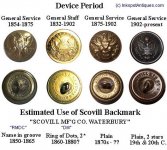My 14 year old nephew found this in his yard outside of Charlotte, N.C. recently with his detector. He accidentally dropped it, so now it’s detached. Superior Quality is stamped on the back, and it appears to have some gilt. Can anyone give me some info I can pass along to him? I found some info online, but I can’t tell if it’s truly old. Thanks in advance.













